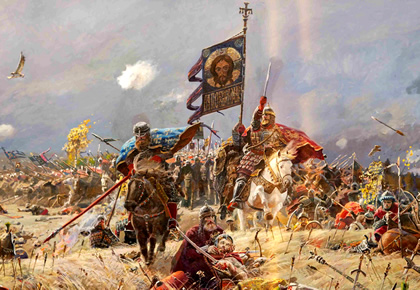 |
| Moscow: Third Rome |
The civilization and culture of the Byzantine Empire with its capital of “New Rome” (Constantinople) greatly influenced the development of Russia. Christian missionaries were sent from the Christian empire to Russia in the ninth century.
Their work bore fruit when, in 988, Prince Vladimir I (Vladimir the Great) of Kiev looked to “New Rome” for spiritual direction and was baptized into Christianity. Vladimir converted Russia to the Christian world. The patriarch of Constantinople appointed a bishop for Kiev and continued to appoint the highest-ranking pre late in the land until the 15th century.
In 1054 the religious division of “Old Rome” and “New Rome” became permanent as Catholic and Orthodox Christianity parted company. Russian Christianity was firmly rooted in the Orthodox sphere in theology, ecclesiology, literature, and liturgy.
In the 13th century Western crusaders conquered Constantinople and much of the Byzantine Empire in the Fourth Crusade and sought to impose Catholic Christianity on the Orthodox empire, while Orthodoxy in Russia suffered a blow as the Mongols destroyed Kiev and established their hegemony that lasted into the late 15th century.
With the destruction of Kiev and the Mongol dominance of the Slavic southern region, the northern city of Moscow began to rise in prominence in the 14th century. In the first quarter of the 14th century the metropolitan of Russia (the highest ranking Orthodox bishop, formerly at Kiev) chose to settle in the city of Moscow.
With the support of the church, Dimitri Donkoi, grand duke of Moscow, defeated the Mongols at the Battle of Kulikovo in 1380. Though their hegemony lasted another century, the Mongol hold on northern Russia was weakened and the prestige of Moscow greatly enhanced.
Moscow viewed itself as upholding the mantle of Orthodoxy against the hostile forces of Catholic Christianity, which had been attacking Orthodox Russia via Teutonic, Knights, Swedes, Poles, and Lithuanians in the 13th and 14th centuries as well as non-Christian forces, such as the Mongols.
Up to this time, the metropolitan of Russia was selected by the Orthodox patriarch of Constantinople. This changed however after the Council of Ferrara-Florence in 1438–39, when the Byzantine Empire, faced with the overwhelming threat of the Muslim Ottoman Turks, submitted the Orthodox Church to the papacy.
 |
| Battle of Kulikovo |
Moscow and Russian Orthodoxy rejected this church council and its submission as antithetical to true Christianity. Henceforth, the Russian church was independent from Constantinopolitan control.
In 1453 Constantinople or “New Rome” fell to the Ottoman Turks. Russian czar Ivan III “the Great” (reigned 1462–1505) married the niece of the last Byzantine emperor and inherited the mantle of the Christian empire that had been established by Constantine I (d. 337), the founder of “New Rome.”
The Russians understood that God had allowed “Old Rome” to be sacked by Germans in the fifth century and shifted the imperial and religious center of Christendom to Constantinople. Now God had decreed that Second Rome should fall.
With the other Eastern Patriarchates (Alexandria, Antioch, Jerusalem) also in Muslim hands, it appeared to the Russian church that it clearly stood as the champion of Orthodoxy and the heir apparent to Orthodox Christian leadership: It was the Third Rome.
Russian monk Philotheus of Pskov articulated this most clearly in his letter to Czar Basil III in 1510: “Two Romes have fallen, but the third stands and a fourth there shall not be.” The czar of Moscow became the new protector of Orthodoxy and in the later 16th century the metropolitan of Moscow was promoted to the rank of patriarch.
EmoticonEmoticon